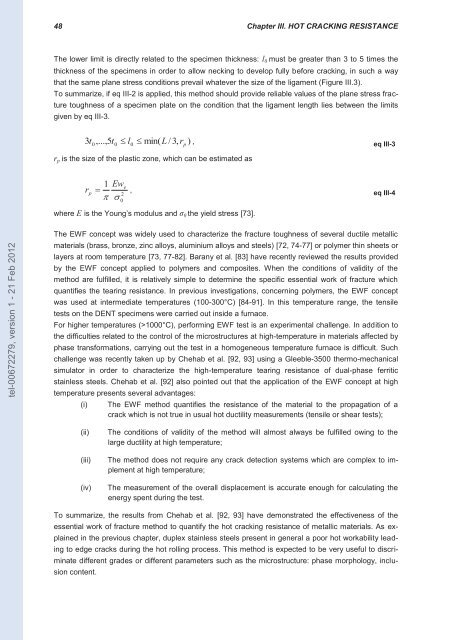Forgeabilité des aciers inoxydables austéno-ferritiques
Forgeabilité des aciers inoxydables austéno-ferritiques
Forgeabilité des aciers inoxydables austéno-ferritiques
You also want an ePaper? Increase the reach of your titles
YUMPU automatically turns print PDFs into web optimized ePapers that Google loves.
tel-00672279, version 1 - 21 Feb 2012<br />
48 Chapter III. HOT CRACKING RESISTANCE<br />
The lower limit is directly related to the specimen thickness: l0 must be greater than 3 to 5 times the<br />
thickness of the specimens in order to allow necking to develop fully before cracking, in such a way<br />
that the same plane stress conditions prevail whatever the size of the ligament (Figure III.3).<br />
To summarize, if eq III-2 is applied, this method should provide reliable values of the plane stress frac-<br />
ture toughness of a specimen plate on the condition that the ligament length lies between the limits<br />
given by eq III-3.<br />
3 0<br />
t0 ,..., 5t0<br />
� l � min( L / 3,<br />
rp<br />
) , eq III-3<br />
rp is the size of the plastic zone, which can be estimated as<br />
1 Ew<br />
rp � , eq III-4<br />
� �<br />
e<br />
2<br />
0<br />
where E is the Young’s modulus and σ0 the yield stress [73].<br />
The EWF concept was widely used to characterize the fracture toughness of several ductile metallic<br />
materials (brass, bronze, zinc alloys, aluminium alloys and steels) [72, 74-77] or polymer thin sheets or<br />
layers at room temperature [73, 77-82]. Barany et al. [83] have recently reviewed the results provided<br />
by the EWF concept applied to polymers and composites. When the conditions of validity of the<br />
method are fulfilled, it is relatively simple to determine the specific essential work of fracture which<br />
quantifies the tearing resistance. In previous investigations, concerning polymers, the EWF concept<br />
was used at intermediate temperatures (100-300°C) [84-91]. In this temperature range, the tensile<br />
tests on the DENT specimens were carried out inside a furnace.<br />
For higher temperatures (>1000°C), performing EWF test is an experimental challenge. In addition to<br />
the difficulties related to the control of the microstructures at high-temperature in materials affected by<br />
phase transformations, carrying out the test in a homogeneous temperature furnace is difficult. Such<br />
challenge was recently taken up by Chehab et al. [92, 93] using a Gleeble-3500 thermo-mechanical<br />
simulator in order to characterize the high-temperature tearing resistance of dual-phase ferritic<br />
stainless steels. Chehab et al. [92] also pointed out that the application of the EWF concept at high<br />
temperature presents several advantages:<br />
(i) The EWF method quantifies the resistance of the material to the propagation of a<br />
crack which is not true in usual hot ductility measurements (tensile or shear tests);<br />
(ii) The conditions of validity of the method will almost always be fulfilled owing to the<br />
large ductility at high temperature;<br />
(iii) The method does not require any crack detection systems which are complex to implement<br />
at high temperature;<br />
(iv) The measurement of the overall displacement is accurate enough for calculating the<br />
energy spent during the test.<br />
To summarize, the results from Chehab et al. [92, 93] have demonstrated the effectiveness of the<br />
essential work of fracture method to quantify the hot cracking resistance of metallic materials. As ex-<br />
plained in the previous chapter, duplex stainless steels present in general a poor hot workability lead-<br />
ing to edge cracks during the hot rolling process. This method is expected to be very useful to discri-<br />
minate different gra<strong>des</strong> or different parameters such as the microstructure: phase morphology, inclu-<br />
sion content.

















